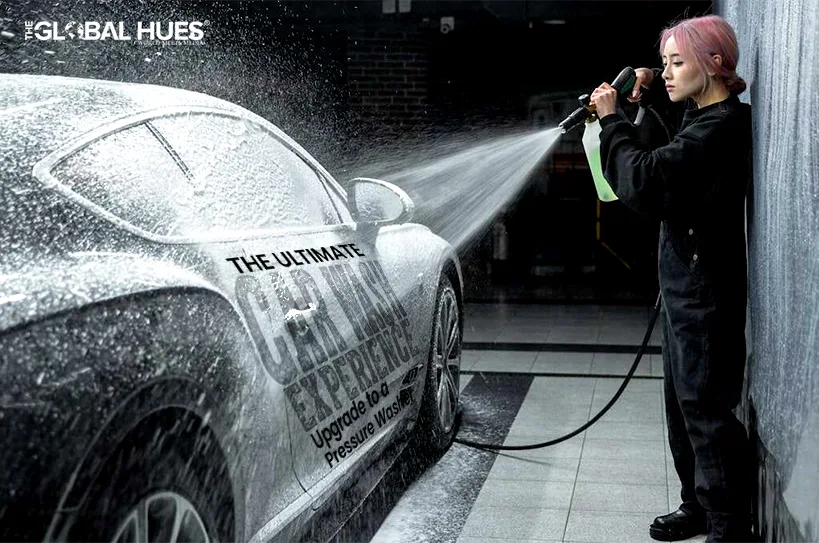Car washing is one of the most important maintenance tasks that car owners should regularly perform. However, using buckets, sponges, and hoses, traditional car washing methods can be time-consuming, physically demanding, and inefficient. Moreover, these methods only sometimes provide a thorough and effective cleaning, especially for cars with hard-to-remove dirt, grime, and stains.
Fortunately, a better way to wash your car is by upgrading to a pressure washer. This article will discuss the benefits and features of a car pressure washer and how they can provide you with the ultimate car wash experience.
What is a pressure washer?
A power washer is a cleaning tool that uses high-pressure water to remove dirt, grime, and surface stains. It consists of a motor or engine that drives a pump, pressuring the water and delivering it through a wand or nozzle.
Pressure washers come in different types, sizes, and power sources, ranging from electric-powered models for home use to gas-powered ones for heavy-duty commercial applications.
Why upgrade to a pressure washer for car washing?
Saves time and effort
With a pressure washer, you can clean your car in a fraction of the time and effort required by traditional methods. The water jet can quickly blast away dirt, grime, and mud from the car’s surface, wheels, and undercarriage. You don’t need to scrub, rinse, or repeat as many times as you would with a bucket and sponge. Moreover, the pressure washer can reach tight spaces, corners, and crevices that are hard to access with a hose or brush.
Provides thorough cleaning
A pressure washer can provide a more thorough and effective cleaning than traditional methods. The high-pressure water can penetrate deep into the pores and cracks of the car’s surface and remove even the toughest stains, such as bird droppings, tree sap, and brake dust. It can also remove salt and road grime that can cause rust and corrosion. Moreover, the washer can disinfect and sanitise the car’s interior and exterior surfaces, reducing the risk of bacterial and viral contamination.
Saves water and reduces environmental impact
A pressure washer can save water and reduce the environmental impact of car washing. Unlike traditional methods that use much water and produce runoff, a pressure washer uses less water and directs it precisely where needed. Moreover, some pressure washers come with detergent injectors that mix soap or cleaning agents with the water, reducing the need for harsh chemicals and minimising water pollution.
Versatile and multi-functional
A pressure washer can be used for other tasks besides car washing. You can use it to clean your driveway, patio, deck, siding, windows, and outdoor furniture. You can also use it to remove graffiti, paint, and rust from metal surfaces. Moreover, some pressure washers come with interchangeable nozzles and attachments that can adjust the pressure and flow of the water for different cleaning tasks.
Features to consider when buying a pressure washer for car washing
If you’re considering buying a car pressure washer, here are some features to consider.
- Pressure and flow rate: A pressure washer’s pressure and flow rate determine its cleaning power, and higher pressure and flow rate mean more cleaning power, cost, and energy consumption. For car washing, a pressure washer with a pressure of 1,200 to 2,000 PSI and a flow rate of 1.4 to 1.6 GPM should be sufficient.
- Power source: Pressure washers can be powered by electricity or gas. Electric pressure washers are quieter, lighter, and more affordable than gas ones, but they also have lower cleaning power and require an electrical outlet. Gas pressure washers are more powerful and portable than electric ones but are louder, heavier, and require more maintenance. The choice of power source depends on your cleaning needs, budget, and preferences.
- Nozzle and wand: The nozzle and wand of a pressure washer determine the water jet’s shape, angle, and intensity. A pressure washer with interchangeable nozzles and wands can adjust the pressure and flow of the water for different cleaning tasks. A nozzle with a 25- or 40-degree spray angle and a wand with a soap dispenser or a rotating brush can provide the best results for car washing.
- Hose length and material: The hose of a pressure washer should be long enough to reach all parts of your car without moving the machine too often. A hose length of 20 to 25 feet is recommended for car washing. The material of the hose should be durable, flexible, and resistant to kinks, abrasions, and leaks. A rubber or PVC hose with brass fittings is a good choice for car washing.
- Detergent tank and dispenser: The car pressure washer has a detergent tank and dispenser that can mix soap or cleaning agents with the water. This can enhance the pressure washer’s cleaning power and reduce the need for manual scrubbing. However, you should choose a detergent that is safe for your car’s paint and finishes and follow the manufacturer’s instructions.
Conclusion
Upgrading to a pressure washer for car washing can provide the ultimate experience. A pressure washer saves time and effort, provides thorough cleaning, saves water, reduces environmental impact, and is versatile and multi-functional. When buying a pressure washer for car washing, consider the pressure and flow rate, power source, nozzle and wand, hose length and material, and detergent tank and dispenser. With a pressure washer, you can keep your car looking clean, shiny, and new for years.



